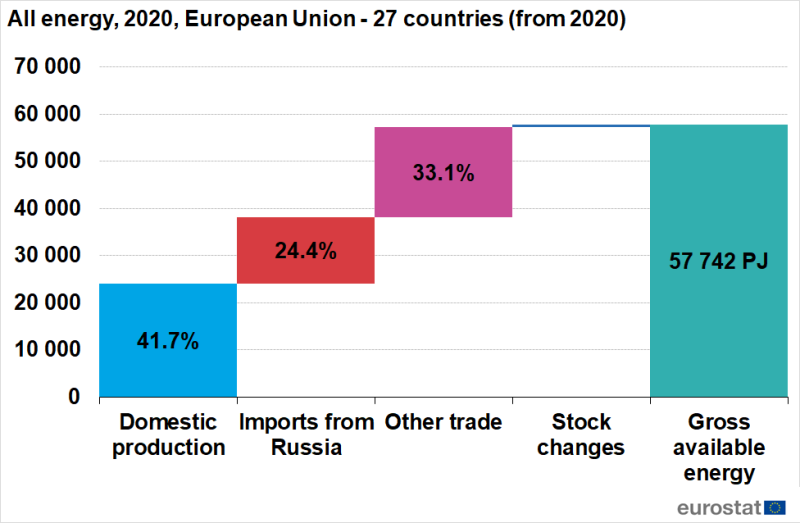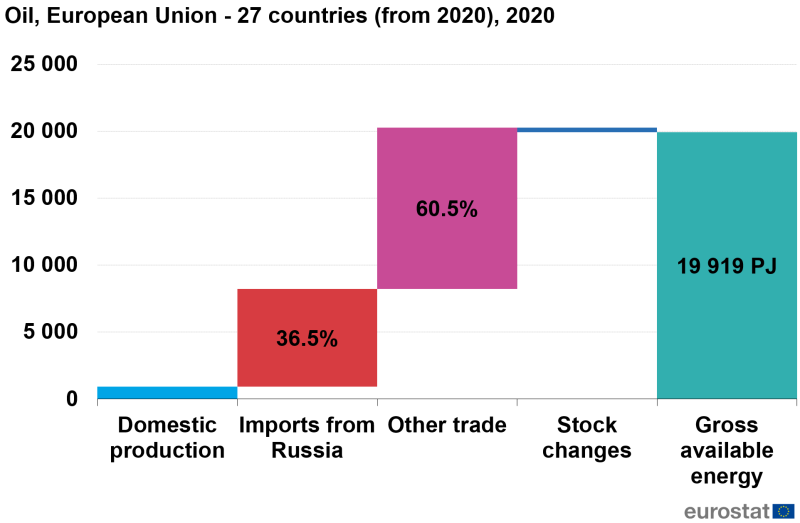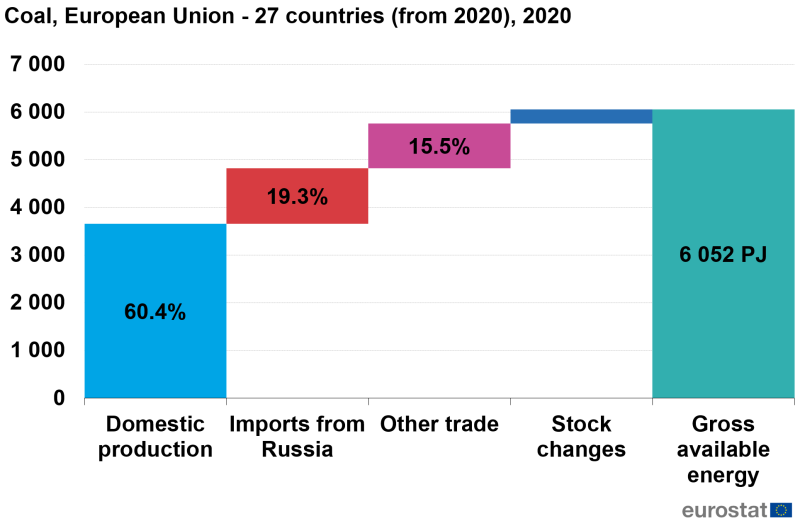Archive:EU energy mix and import dependency
Data extracted on 4 March 2022
Planned article update: February 2023
Highlights
In 2020, energy imports from Russia were 24.5% of total EU's energy needs.
Tweet Text
Russia is the most important trading partner of the EU for imports of natural gas, oil and hard coal. This SE article presents the EU’s energy supply exposure to the imports from Russia.
Full article
Natural gas
The reliance of the European Union on Russian natural gas has increased over the last decade. Natural gas consumption in the EU remained broadly flat over this period, but production fell by a third and the gap has been filled by increased imports. On average, the EU relies on Russia for XX% of its natural gas imports.
Oil
Russia is the world’s third largest oil producer after the United States of America and Saudi Arabia. Russia is the world’s largest exporter of oil (crude oil + petroleum products). On average, the EU relies on Russia for XX% of its oil imports.
Coal
On average, the EU relies on Russia for XX% of its hard coal imports.
Glossary, concepts and methodology notes
Coal = Anthracite + Coking coal + Other bituminous coal + Sub-bituminous coal + Lignite + Coke oven coke + Patent fuel + Brown coal briquettes + Coal tar + Peat + Peat products + Oil shale and oil sands
Oil = Crude oil + Natural gas liquids + Refinery feedstocks + Additives and oxygenates (excluding biofuel portion) + Other hydrocarbons + Refinery gas + Ethane + Liquefied petroleum gases + Naphtha + Aviation gasoline + Motor gasoline (excluding biofuel portion) + Gasoline-type jet fuel + Kerosene-type jet fuel (excluding biofuel portion) + Other kerosene + Gas oil and diesel oil (excluding biofuel portion) + Fuel oil + White spirit and special boiling point industrial spirits + Lubricants + Paraffin waxes + Petroleum coke + Bitumen + Other oil products n.e.c.
Renewables = Hydro + Geothermal + Wind + Solar thermal + Solar photovoltaic + Tide, wave, ocean + Ambient heat (heat pumps) + Primary solid biofuels + Charcoal + Pure biogasoline + Blended biogasoline + Pure biodiesels + Blended biodiesels + Pure bio jet kerosene + Blended bio jet kerosene + Other liquid biofuels + Biogases + Renewable municipal waste
Total = Natural gas + Oil + Coal + Nuclear + Renewables + Industrial waste (non-renewable) + Non-renewable municipal waste + Electricity + Heat
Gross available energy = Primary production + Recovered and recycled products + Imports + Exports + Change in stock
Domestic production = Primary production + Recovered and recycled products
Imports from Russia is calculated based on import data for individual fuels and the individual shares are subsequently aggregated in common energy units (TJ).
Other trade = Imports - Exports - Imports from Russia
Gross available energy = Domestic production + Imports from Russia + Other trade + Change in stock
In energy statistics, the following conventions apply:
- production of electricity and heat in nuclear installations is cosidered as domestic production, regardless the actual origin of uranium/plutonium
- production of biofuels from imported biomass feedstock is considered domestic production of biofuels, regardless the actual origin of biomass feedstock
- international trade (imports/exports) is considered based on physical border crossing regardless of customs procedures
- countries should report ultimate origin of fuels for imports (country where the fuel was extracted) and in egeneral reporting should exclude transit
- use of fossil fuels is including also non-energy consumption, such as use of natural gas in chemical industry, bitumen in construction or lubricants for lubrification
- EU aggregate is calculated as sum
of individual countries and there for trade it includes intra-EU trade Specific notes for reporting trade (imports/exports) in energy statistics:
- some countries report transit as imports and exports
- some quantities are considered confidential (e.g. reporting of Austria for natural gas trade)
- purchases on international sport markets (trade hubs) are sometimes allocated to the country of purchase, instead of country of origin
- some countries cannot identify exact origin and therefore report such quantities under the transit country (e.g. Germany) or under "non specified" category
Source data for tables and graphs
Data sources
<description of data sources, survey and data availability (completeness, recency) and limitations>
Context
<context of data collection and statistical results: policy background, uses of data> Having a secure supply of energy is crucial for the well-being of European citizens and the economy. The EU works to ensure that energy supplies are uninterrupted and energy prices remain stable.
Direct access to
See also
Main tables
- Gross available energy by product (ten00121)
Database
- Energy (nrg), see:
- Energy statistics - quantities, annual data (nrg_quant)
- Energy balances (nrg_bal)
- Complete energy balances (nrg_bal_c)
- Energy indicators (nrg_ind)
- Energy imports dependency (nrg_ind_id)
- Trade by partner country (nrg_t)
- Imports (nrg_ti)
- Imports of solid fossil fuels by partner country (nrg_ti_sff)
- Imports of oil and petroleum products by partner country (nrg_ti_oil)
- Imports of natural gas by partner country (nrg_ti_gas)
- Imports of biofuels by partner country (nrg_ti_bio)
- Imports of electricity and derived heat by partner country (nrg_ti_eh)
- Imports (nrg_ti)
- Energy balances (nrg_bal)
- International trade in goods - aggregated data (ext_go_agg)
- International trade in goods - long-term indicators (ext_go_lti)
- International trade in goods - short-term indicators (ext_go_sti)
- International trade in goods - detailed data (detail)
Dedicated section
Methodology
Legislation
Visualisations
External links
Notes
<footnote text will be automatically inserted if reference tags are used in article content text (use reference icon on ribbon)>
[[Category:<Subtheme category name(s)>|Name of the statistical article]] [[Category:<Statistical article>|Name of the statistical article]]
Delete [[Category:Model|]] below (and this line as well) before saving!



